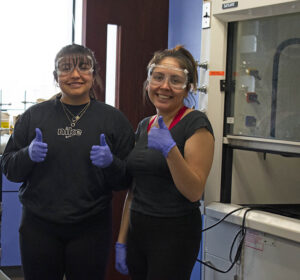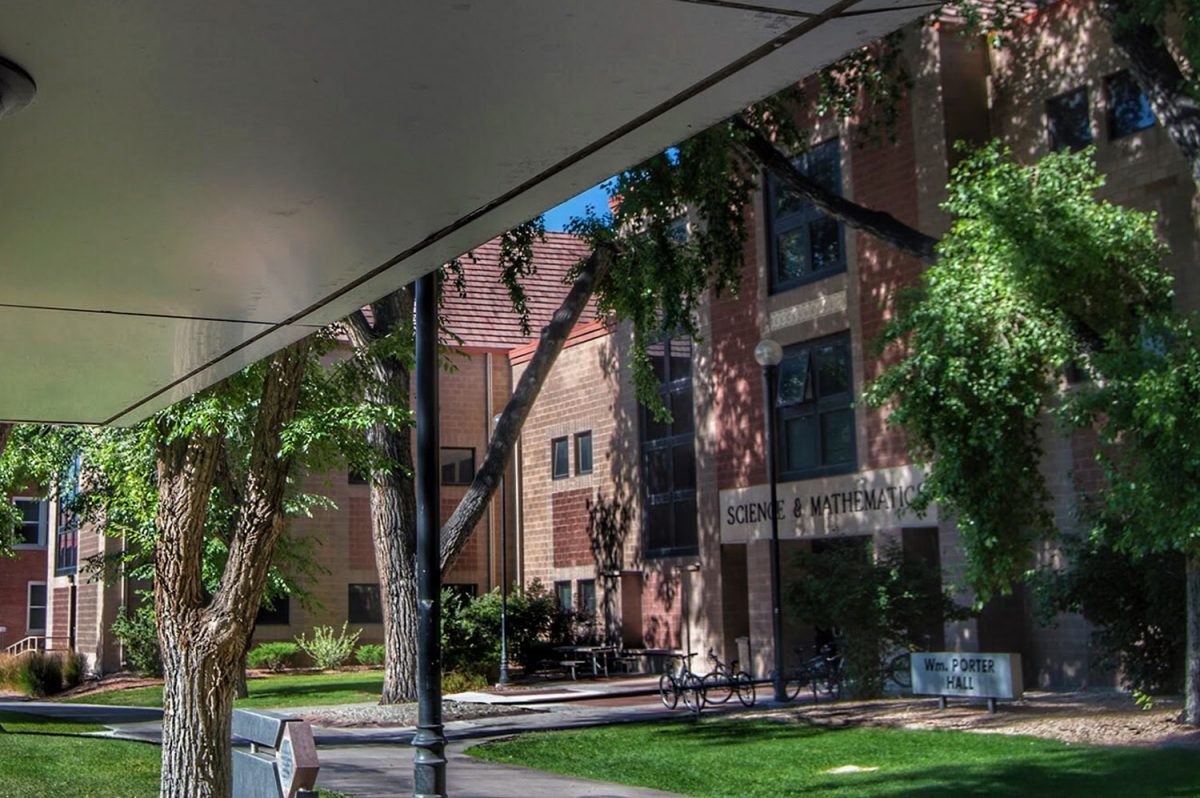Advancing Women in STEM through Institutional Transformation at Adams State University
 National Science Foundation’s ADVANCE IT-Catalyst program aims to increase diversity and gender equity among Adams State’s faculty in Social and Behavioral Sciences and Science, Technology, Engineering & Mathematics.
National Science Foundation’s ADVANCE IT-Catalyst program aims to increase diversity and gender equity among Adams State’s faculty in Social and Behavioral Sciences and Science, Technology, Engineering & Mathematics.
Contact the Principal Investigator
Matt Nehring, Ph.D.
Professor of Physics
matt.nehring@adams.edu
Institutionalization Plan
Advocates and Allies Group
- The Advocates and Allies groups consist of men faculty and staff who have been trained to be more aware of gender biases on campus and to promote gender equality.
- A small group of men faculty and staff advocates, named the MAGEs (Men Advocates for Gender Equity), have developed a mission and strategic plan for moving forward. Their mission is to increase awareness among men employees about gender inequity on campus, take ownership and responsibility in how men participate in systems that perpetuate gender bias and discrimination, and pursue an equitable climate by addressing, challenging, and eliminating gender inequities at Adams State. The strategic plan includes building an active network of Adams State men allies, hosting regular workshops and discussions to train men on gender bias, and promote and support gender equity in policy and practice.
- A faculty member has been appointed lead of the group and is committed to growing this program. There are enough interested men in this work that it has momentum to continue moving forward.
Mentoring Circles
- The Mentoring Circles project seeks to shift campus culture by creating a sustainable professional mentoring series centered around equity and justice issues to catalyze change. This program began with support from the ADVANCE and Title V grants.
- Seven mentoring circles have occurred in which a faculty or staff member led a discussion on a relevant literature or research article. Former topics include: imposter syndrome, Black male learners, gender biases in service expectations, and negotiating student/professor boundaries in a small town.
- As this program is led by faculty and staff on the campus, under the support of a faculty mentoring coordinator, therefore there is momentum for its continuation.
Faculty Handbook Changes
- Changes to the faculty handbook were developed by the ADVANCE team with input from other campus constituents. These changes focus on the faculty expectations and evaluation and fall under four general topics:
- Addition of language related to diversity and inclusive excellence
- Removal of language that may lead to evaluation bias
- Addition of language related to lifelong learning of best teaching practices
- Addition of language related to assessment and learning outcomes.
- The proposed changes were vetted through department discussions, all-campus forums, and the faculty senate handbook committee. The changes have been submitted to the Colorado Attorney General. When returned, these proposed changes will be voted upon by faculty with the hope of presenting these changes to the Adams State Board of Trustees for insertion into the faculty handbook for the 2020/21 academic year.
Changes to Search and Hiring Practices
- Examples of job advertisement wording, search rubrics, and interview questions reflecting best practices in increasing faculty diversity have been created and made available to all search committee chairs through the Office of Equal Opportunity.
- Diversity Advocate training has been on-going and currently 64 individuals have been trained. It is a practice applied by the OEO that an advocate is a member of the search committee for each search.
- Training for Diversity Advocates takes place on Everfi, an online training program that the university purchases.
Further Work Needed
- Lack of sufficient and flexible childcare options in the local community and on campus continue to be a need stressed by female and male faculty.
- Tuition remission for dependents of Adams State University faculty and staff has remained a request for over a decade. A task force should be formed to re-address this issue.
- Bias trainings need to be developed and implemented for the chairs of retention, tenure, and promotion committees.
- Structured rubrics for faculty evaluation need to be developed. A group of department chairs plan have taken up this task and plan on having first drafts done by the end of the fall semester to be presented to academic council. In order for these rubrics to be institutionalized, they need to be approved through faculty senate and a campus-wide vote.
Key Findings
Across Campus, Compared to their Male Colleagues
- Women in non-STEM/SBS fields received higher student evaluations
- Female faculty started at a higher pay level and increased pay at a faster rate
- Women took one year longer to achieve promotion to full professor
In STEM and Social Sciences, Compared to their Male Colleagues
- Women received lower student evaluations, however students were more likely to use positive words associated with learning
- Women spent their time differently; they are more likely to take on significant administrative and service roles, whereas men are more likely to spend time on research and grant-related work.
- Women were twice as likely to report sexual harassment, bullying, and intimidation
- Women appreciated the parental leave policy, however differences in housework and childrearing duties still persist
- Women took an additional three years to achieve promotion to full professor
- Women spent more time in student interactions outside of the classroom
In STEM and Social Sciences
- Women and men spent equal amount of time on teaching and are on an equal number of committees
- Both genders reported the most likely reason to leave Adams State would be to earn a greater salary
- Both genders spent significant time caring for family
- Lack of quality childcare and tuition waivers were concerns for both genders
Recommendations
- Create clear, well-defined goals for retention, tenure, and promotion. This will reduce bias and the sliding scale effect.
- Ensure that significant service or significant research is counted for promotion equally. Or if not, create a clear point system/rubric for service and student interaction.
- Ensure all retention and promotion members are trained with respect to gender biases, specifically as they relate to teaching evaluations, service, and research obligations
- Encourage men to take the parental leave, if applicable.
- Create a taskforce to address lack of childcare options in Alamosa and on-campus
Study Summaries
Salary Comparisons
- Examined salary data for tenure-track professors in all fields, years 2012 – 2016
- Women (n = 23) were hired at a 7% higher salary compared to men (n = 29). This gap increased over time for faculty that have been at Adams State less than 10 years: 13% salary gains for female faculty and 4% salary gains for male faculty.
- Female faculty had a higher ratio of total compensation to base salaries (23% compared to 18% for men), which may be an indication of higher amounts of extra duties assigned to female faculty.
- Female faculty spent one year longer at the associate level.
- Male faculty spent more years at Adams State (mean = 11.96, SD = 9.54) compared to female faculty (mean = 9.48, SD = 8.25
- No significant gender effects were found for retention rates
Student Evaluations of Teaching Comparison
Quantitative Analysis
- Compared male and female faculty student evaluation scores in the STEM/SBS fields (n = 1,760) and in the non-STEM/SBS fields (n = 3686) for Fall 2012-Fall 2016
- In STEM/SBS, male faculty scored significantly higher on Instructor Enthusiasm, Subject Knowledge, Instructor Encouragement, Instructor Accessibility, Preparation of Course Material, Course Objective Met, and Overall Evaluation score. There were no significant differences in the other categories.
- In non-STEM/SBS fields, female faculty scored significantly higher in Enthusiasm, Enhancement of Student Knowledge, and Course Objectives Met. There were no significant differences in the other categories.
- A General Linear Model was used to compare female and male STEM/SBS faculty. It was found that male professors, higher ranked professors, and upper division courses garnered the higher evaluations.
Word Frequency Analysis
- Written comments from student evaluations for STEM/SBS faculty from 2012 – 2017 were analyzed for word frequency (over 300,000 words)
- A separate analysis was done for male and female faculty
- Students evaluations for female faculty contain more positive words associated with positive learning experiences (such as learn, enjoy, best, love, enthusiasm, favorite, organized)
- Students were more likely to use the word fun in their evaluations of male faculty
Time Log Study
- Ten STEM/SBS faculty (female = 7, male = 3) completed time log charting of daily tasks for two weeks, recording activities performed in 15 minute increments. Only one SBS faculty member completed the log along with three department chairs.
- Men and women spent the same amount of time on teaching and community service.
- Female STEM faculty spent more time on class prep, grading, advising, committee meetings, committee work, student engagement, and childcare. Male STEM faculty spent more time e-mailing, reading for work, grant work, and research.
- Overall, these women spent double (2.19) the amount of time on service, 1.41 the amount of time on student advising/mentoring, and one-tenth (0.14) the amount of time on research/grant work compared to their male colleagues.
Focus Group Study
- Two one-hour focus groups were conducted in conjunction with the time log study. There were different focus groups for men, women, and department chairs.
- 9 STEM/SBS Faculty (Males=3; Females=6) completed the first focus group, 11 (Males = 4, Females = 7) completed the second focus group.
- Major themes found were: participants were curious about the time log process and concerned that the time log may not be representative of their time, both men and women discussed differences in student perceptions of faculty related to gender and differences in expectations for service. Men were more likely to set aside time to work on a specific task, women were more likely to describe multitasking. Both men and women described the RTP process as a moving target and described shifting expectations during their time at Adams State. Finally, both men and women noted there were fewer female full professors at Adams State and fewer female role models.
Faculty Survey
- A survey, composed of relevant questions taken from the report of the promotion, gender, race, ethnicity and service committee from University of Massachusetts Boston and the Faculty Job Satisfaction Survey, was sent to all faculty in STEM and SBS in March 2018. Sixteen surveys were completed (female = 9, male = 7).
- There no were no differences found in number of committees that faculty participated in, however women reported more than double the hours spent on service work at the institutional and profession level compared to men (67 hours/semester vs. 30 hours/semester).
- No significant difference in advising was found by gender. There were both male and female faculty with large numbers (>50) of advisees. Women reported more time spent assisting students with interpersonal struggles.
- No men reported experiencing sexual harassment, whereas half the women did.
- Female faculty reported double the experiences of bullying and intimidation compared to their male colleagues (80% vs. 40%).
- Both genders were dissatisfied with the lack of tuition waivers.
- Women were most satisfied with teaching, men were most satisfied with health benefits.
- Both genders indicated the most likely reason to leave Adams State would be to improve their salary.
- No differences were found in professional development and leadership opportunities.
- Women took longer to get promoted. Women spent an average of 7 years as associate, while men spent an average of four years.
Limitations on Studies
- Data was not disaggregated by race/ethnicity because of the small sample size and potential loss of anonymity.
- A case study of STEM/SBS female faculty who had left the institution between 2012 – 2018 (n = 10) did not deliver any useful trends as only three former faculty agreed to be interviewed.
- All three department chairs were female during the time log and faculty survey. This could skew the data for female faculty in favor of administrative duties.



